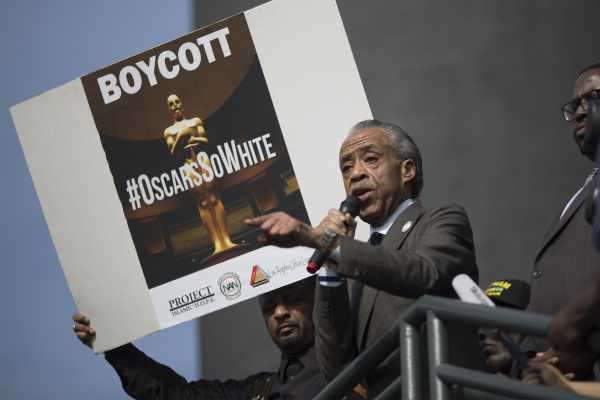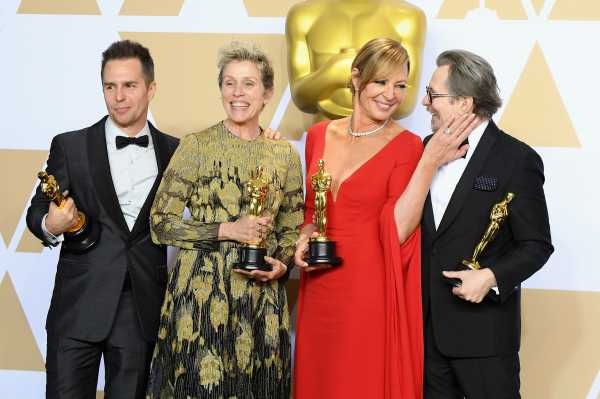
The Oscars are rounding the corner toward its 100th birthday — next year’s ceremony, whatever form it takes, will be the 93rd — but the awards show is far from set in its ways. Just in the last year, the Academy of Motion Picture Arts and Sciences, the professional organization that gives out the Oscars, has shifted the rules to rename a category and accommodate a pandemic. Not long ago, the organization was toying with a new “Best Popular Picture” category, although whether it will ever actually be awarded is unclear. And a few short years ago, the membership guidelines changed in order to deal with its diversity problems.
And now, the guidelines are changing again. The Academy has announced changes to the Best Picture category, aimed at the lofty goal of making Hollywood more diverse.
Related
The 2021 Oscars are moving to April due to the pandemic. Should they?
But it’s caused some confusion, with people (some of whom don’t seem to have actually read the guidelines before weighing in) alternately cheering and booing the changes. So here’s a quick guide to the guidelines, what they actually mean for the Oscars, and whether they’ll have any effect on either the show or the industry at large.
What are these new Oscar rules?
On September 8, the Academy announced a set of new eligibility guidelines for films aiming to compete for Best Picture, considered the top prize at the Oscars.
There are four categories of inclusion standards. You can read the full standards on the Oscars website, but they basically break down into two big buckets: standards promoting more inclusive representation and standards promoting more inclusive employment. Movies will need to meet the standards in two of four categories in order to qualify.
First, a note. This gets wordy fast, so to make it easier, I’ll use the following terminology:
- The Academy designates “underrepresented racial or ethnic groups” within the standards to include Asian, Hispanic/Latinx, Black/African American, Indigenous/Native American/Alaskan Native, Middle Eastern/North African, Native Hawaiian or other Pacific Islander, or “other underrepresented race or ethnicity.” I’ll refer to this category as underrepresented racial or ethnic groups.
- The Academy also designates a broader set of identity groups within the standards, which includes the underrepresented racial and ethnic groups listed above as well as women, LBGTQ+ people, and people with cognitive or physical disabilities, or who are deaf or hard of hearing. For simplicity’s sake, I’ll refer to this group taken together as underrepresented identity groups.
The first category of standards (which the Academy calls Group A) deals with the stories or characters on the actual screen. In this category, movies must have one of the following:
- At least one “lead or significant supporting actor” from an underrepresented racial or ethnic group. Or …
- At least 30 percent of a cast in secondary and minor roles from two underrepresented identity groups. Or …
- A main storyline or subject that centers on an underrepresented identity group.
Group B standards regard the creative and production team behind the film. To meet these standards, a film must meet one of the following criteria:
- At least two heads of major departments (such as editing, director, makeup and hairstyling, costuming, or sound, as well as many others) must be from an underrepresented identity group. Additionally, a minimum of one of these must be from an underrepresented racial or ethnic group. Or …
- At least six people on the crew (excluding production assistants, generally the entry-level position on set) are from an underrepresented racial or ethnic group. Or …
- At least 30 percent of the crew are from an underrepresented identity group.
Group C standards have to do with the (paid) training opportunities that film companies offer groups of people who are underrepresented in Hollywood. There’s some fine print here distinguishing between huge companies with deep pockets (like Disney and Warner Bros.) and smaller companies or independent productions. But in general, to qualify in this category, the film’s production company or distributor must meet both of these two standards:
- Must offer paid internship or apprenticeship opportunities, in a variety of departments, to people from underrepresented identity groups, and must actually be employing people in those positions (numbers vary according to the size of the company). And …
- Must offer training and work opportunities in “below the line” (essentially, lower- and mid-level positions) to people from underrepresented identity groups.
Group D standards deal with “audience development,” with is Hollywood’s way of talking about the parts of the business that get people to buy tickets to movies. To qualify in this category, the studio or company distributing the film must have “multiple” senior-level executives from underrepresented identity groups on their marketing, publicity, or distribution teams.
Remember: Films will only need to meet the standards in a minimum of two of these four groups in order to be eligible to compete for Best Picture.
Additionally, these rules don’t kick in until the 2024 Oscars (which, because of the way awards calendars work, covers movies released in 2023), which means that they won’t apply to movies that come out in 2021 or 2022.
However, beginning with films released in 2021, filmmakers will need to submit a confidential form that indicates how closely their films align with those standards in order to be eligible; presumably, they will still be eligible if they don’t comply, but the data will help both the companies and the Academy see where there are still gaps in the industry’s inclusion efforts.
It’s important to note that this is only for the Best Picture category — so a film could not meet these standards and still be eligible for other awards.
Why is the Academy changing the rules?
Great question! In short, though Hollywood is inching toward more diversity, problems persist. The first is that, for a variety of reasons, Hollywood — that is, the American film industry — is still predominately a place where white men, and to a lesser extent white women, from well-off backgrounds fill the key decision-making positions at major studios as well as “mini-major” and independent production companies.
White men still also direct most of the movies, write most of the movies, and produce most of the movies, especially the ones with big budgets. (They’re also still most of the film critics, but critics don’t work for Hollywood, so that’s on media companies.) That has, for a long time, had a visible effect on which stories get told, who gets money to tell them, who gets to fail and continue working, and — most pertinently for the Academy — which movies get rewarded at the Oscars.
The Annenberg Inclusion Initiative at USC has done a great job documenting and studying the lack of diversity in Hollywood, if you’d like to read more.
Related
Why the wrong movies win Oscars
Because membership in the Academy is based on factors like years spent working in Hollywood, awards won, and name recognition, and because membership in the Academy is for life, the makeup of the voting body has long been heavily slanted toward older white men. A Los Angeles Times investigation in 2012 found that the median Oscar voter was a white man around age 65. The membership was 94 percent white and 77 percent male; only 2 percent of the Academy was Black, and less than 2 percent identified as Latinx. The LA Times also found that only 14 percent of the membership was younger than age 50.
Following the LA Times investigation and, later, the #OscarsSoWhite embarrassment, the Academy began making strides toward expanding its membership, making it more representative of the American moviegoing public at large. That meant inviting more racially and ethnically diverse people to join, and larger numbers of younger people.
Today, after years of inviting record numbers of new members, the Academy has increased its diversity. Between 2015 and 2020, the percentage of female members increased from 25 percent to 33 percent. The percentage of people from underrepresented racial and ethnic groups has grown from 10 percent to 19 percent. (Full statistics are available through the Oscars website.) At a glance, that doesn’t look like a huge increase, but since people who have been members for decades remain in the organization even as new members are added, that percentage will take years to shift.

The percentage of Academy members is not directly tied to or predictive of Best Picture nominees, nor nominees in any other category. But the group is recognizing a fuller range of experiences, one that more closely matches the actual moviegoing audience, in its voting body. And so, the Academy is aiming to expand the pool of possibility away from what has, in the past, been traditionally considered an “Oscar movie” and what has been considered “niche.” The new eligibility guidelines are another move toward that goal.
Does this mean a movie like The Irishman wouldn’t be eligible for Best Picture in future years?
The Irishman fits the bill just fine.
Yes, it’s a movie directed by a white man, mostly starring white men. But many of Scorsese’s longtime collaborators are (mostly white) women, including producer Emma Tillinger Koskoff; casting director Ellen Lewis; and editor Thelma Schoonmaker, who has been working with Scorsese from the very beginning. The film’s cinematographer, Rodrigo Preto, is from Mexico. Those staffing decisions fulfill the requirements of Category B. The film was funded and distributed by Netflix, a company that includes many women and many people of color among its executive team, including in key communications and publicity positions, and promotes internal development programs focused on diversity and inclusion — all factors in fulfilling Categories C and D. And that doesn’t take into account any LGBTQ+ people or people with disabilities — factors that aren’t obvious if you’re just perusing IMDb, or may not be publicly known — who might be involved.
What about Little Women?
Little Women, being about, well, women, easily meets the criteria for Category A, even though its main cast is entirely white. It’s also directed by a woman, produced by a team of women, and largely employed women as department heads. And though you certainly can’t tell if a person fits into one of the broader Academy-designated underrepresented groups purely on name and picture, a quick scan of the IMDb page makes it pretty clear that at least 30 percent of the crew fits the requirements of Category B. (That doesn’t even take into account Categories C and D at Sony Pictures Entertainment, the film’s distributor, which recently launched a diversity and inclusion initiative, nor the categories of LGBTQ+ people and people with disabilities.)
Related
How to win an Oscar
What about Green Book?
The 2019 Best Picture winner took a lot of (in my view, deserved) flak for its regressive and whitewashed view of race in America. But it also easily passes the test. Mahershala Ali won his second Oscar for his role in the film, which certainly qualifies as a “significant supporting actor” (and thereby fulfills Category A). Among its executive producers are Octavia Spencer and Kwame L. Parker (which fulfills Category B). It was distributed by Universal Pictures, which is led by chairwoman Donna Langley; Universal’s head of distribution is Veronika Kwan Vandenberg, and its head of global communications is Cindy Gardner (Category D). And Universal has an established global talent development and inclusion program (Category C).
These three examples are all films from big studios with money to throw around, of course. But a film like, say, Moonlight — the lowest-budget film to ever win a Best Picture Oscar, at $1.5 million — would have qualified easily, given that most of its cast are Black, its director Barry Jenkins is Black, Jenkins’ co-writer Tarell Alvin McCraney is Black (and gay), a number of heads of key departments are Black, and the movie’s main storyline focuses on a Black, gay character.

Is this just empty signaling, then? Or will the new guidelines have an effect on Hollywood?
It’s hard to say right now, of course. In fact, it feels like films will have to work hard not to be able to tick off two of four boxes.
But that might be the point.
Submitting a film for Best Picture consideration will require the submission of a confidential form for two years before the guidelines go into effect. That means film companies aiming for awards will have a chance to see if they are lacking in a key area and correct that blind spot before 2024.
The easiest way to ensure that a company’s films will be eligible for Best Picture is to do two things: establish ongoing paid internships, apprenticeships, and career opportunities for people from underrepresented groups; and ensure that people from underrepresented groups are in key audience development positions in the company. Then even the whitest, straightest, most cisgendered-male movie about people with no disabilities, created and directed and produced by the same, would still qualify, provided the company itself was promoting inclusion and diversity.
That’s an option more accessible to large film studios because they have the resources to pour into developing talent. And yet, a significant number of low- and mid-budget movies, which may be produced by companies without those resources, generate good buzz at film festivals and are then bought by larger companies. Then they’ll be able to take advantage of their distributors’ investment in diversity and inclusion initiatives.
Of course, a company could elect not to focus on those kinds of initiatives, either because they don’t have the resources or for some other reason. But if they produce or distribute a film that is about an underrepresented ethnic or racial group, women, LGBTQ+ people, or people with disabilities, and if people from those groups are also in key artistic positions or comprise at least 30 percent of the crew, then the film will still qualify for Best Picture consideration.
Overall, though, it seems clear that the Academy’s new eligibility guidelines are designed mostly to encourage different hiring and development practices, even more than promoting greater diversity in the stories that audiences see on screen.

Are there potential issues with this? Absolutely. You can imagine a film company in which tokenism is promoted, with apprenticeship and internship programs that lead nowhere, the minimum number of people from underrepresented groups promoted into key positions, and a lot of lip service paid to diversity and inclusion with very few results. You can also easily imagine — because it happens all the time right now — a world in which movies about people of color are made by largely white creative teams (like, for instance, Disney’s recent live-action remake of Mulan), yet qualify because of the production company’s diversity initiatives.
Similarly, the guidelines make a lot of equivalences that seem, at best, problematic. Is being gay the “same” as being Black? Is being trans the “same” as being deaf? Is being a woman the “same” as being of Asian descent? Some of the underrepresented categories are more consistently discriminated against than others, explicitly or implicitly, and guidelines such as these could simply lead to even more rigid, unspoken hierarchies in hiring — a proposition that’s a bit horrifying to consider.
The Academy has given themselves a few years to see whether this produces an effect and perhaps iron out some of the wrinkles, so it’s possible we may see tweaks and changes to the guidelines in the future. As of right now, though, it’s somewhat hard to think of recent Best Picture nominees that wouldn’t qualify under these rules, or wouldn’t easily qualify with a few company- or crew-level tweaks.
It seems like this won’t fix the #OscarsSoWhite problem, though
Correct! These rules only apply to films submitted for Best Picture consideration. And given that a movie with an all-white cast, or story focused primarily on men, is still eligible, it doesn’t even guarantee that the Best Picture nominees will focus on significantly more diverse stories than they have in the past.
That said, movies are usually trying to qualify in a number of different categories, and most films that are aiming for the Oscars at least secretly dream of getting a Best Picture slot. So the rules could have some trickle-down effect on casting choices and on which films get the “buzz” that can help propel individual performers, directors, writers, and others into the individual categories. But that’s far from a given.
That’s always the issue with trying to generate massive, industry-wide systemic change, especially in an industry like Hollywood, which pays a lot of lip service to inclusivity but is, fundamentally, conservative, and averse to whatever the people at the top perceive as risks — whether that risk is the perception that “Black films don’t travel” or that “men won’t go see a film about women.”
So are the Oscars going to look significantly different in 2024 than they have for the past decade? It’s impossible to know, but there’s no guarantee that they will. Yet if the goal of these eligibility guidelines is to incentivize investing in a more diverse, inclusive workforce, it may have some impact — even in a limited way.
Help keep Vox free for all
Millions turn to Vox each month to understand what’s happening in the news, from the coronavirus crisis to a racial reckoning to what is, quite possibly, the most consequential presidential election of our lifetimes. Our mission has never been more vital than it is in this moment: to empower you through understanding. But our distinctive brand of explanatory journalism takes resources — particularly during a pandemic and an economic downturn. Even when the economy and the news advertising market recovers, your support will be a critical part of sustaining our resource-intensive work, and helping everyone make sense of an increasingly chaotic world. Contribute today from as little as $3.
Sourse: vox.com





